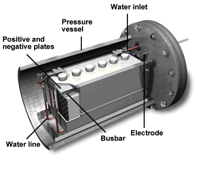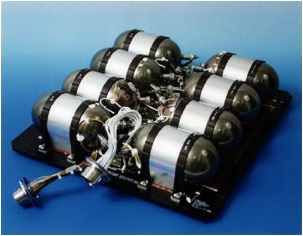Power Conversion and Storage
Converting Power
In order to make the power generated by the solar cell arrays useful and available during disruption of sunlight, it is necessary to have a power conversion and storage system. Power conversion is required because some components of the satellite are likely to not use voltage levels in the kilowatt range. Although communications and propulsion may use this level of power, devices such as sensors and computational circuitry will use much less power. The way a solar cell provides power is that it has approximately constant voltage while current varies by the amount of solar energy received. Therefore, it is necessary to both ramp down the voltage and put a limit on the current sent to low power devices. The most efficient solution is to create groups of systems on the satellite with identical power specifications. Then, each of these systems will have its own power conversion unit to make sure it is receiving the correct levels of voltage and current.
Battery Energy Storage
Another essential aspect of a solar power system is the ability to store energy for when incoming solar radiation is disrupted. This usually occurs when the body that the satellite is orbiting eclipses the star for a period of time. The main energy storage method for satellites is rechargeable batteries. These batteries need a large enough energy capacity to ensure that sunlight is available again before they run out of stored energy. A charge controller is also needed, which is connected between the solar arrays and the batteries. This prevents reverse current flow into the solar arrays and prevents the batteries from being overcharged, preserving their lifetime.
The batteries that will be used for this satellite are nickel-hydrogen batteries, currently one of the most popular for use in satellites. This type of battery is like a combination between a nickel-cadmium battery and a fuel cell. Some of the advantages of this type of battery include a long lifetime, low cost, thermal management capability, and high specific energy. For these reasons, it is ideal for high power and long duration missions.

Figure 1. A cutaway of a typical nickel-hydrogen battery.
One problem with using rechargeable batteries in the very low temperature of space is that they have a liquid component that is necessary for them to function. The way this will be solved is the use of a heat transfer system between the solar cell array and the batteries. Some data collected from the SCARLET solar cell array, predecessor to SLASR, indicates that the solar cells averaged 71° C. This heat energy can be transferred to the batteries through a heat sink system, such as copper tubing. This, along with layers of insulation, will make sure that the batteries are warm enough to function, plus keep enough heat to last through periods of solar light interruption.

Figure 2. A series of nickel-hydrogen batteries used in the Mars Global Surveyor.
Picture credits:
http://micro.magnet.fsu.edu/electromag/electricity/batteries/nickelhydrogen.html
http://www.grc.nasa.gov/WWW/Electrochemistry/doc/nih2.html